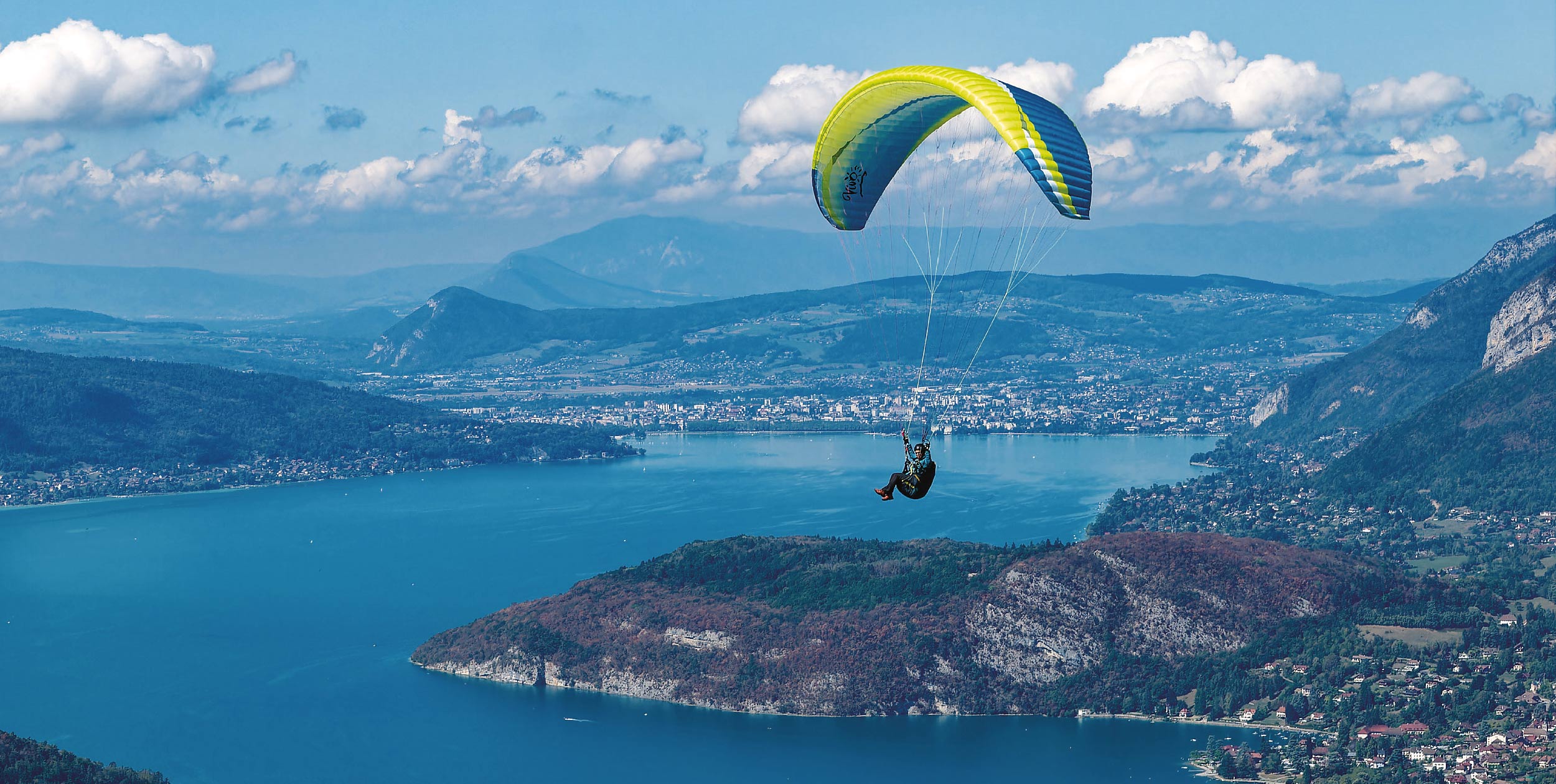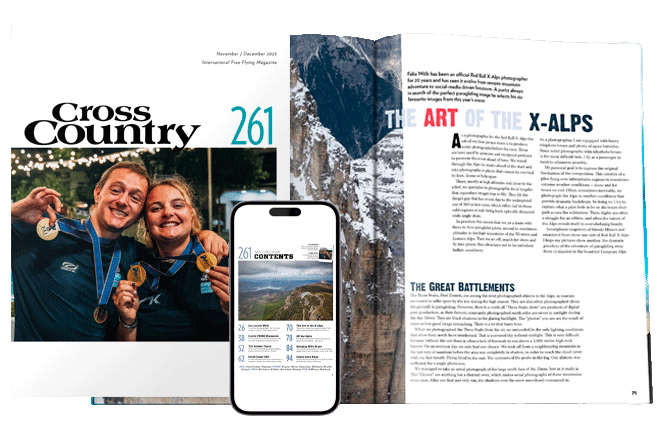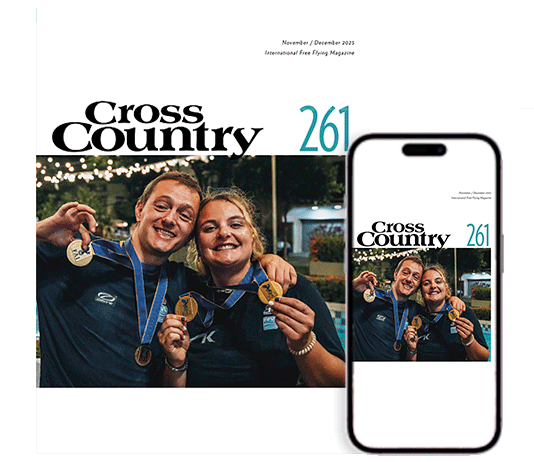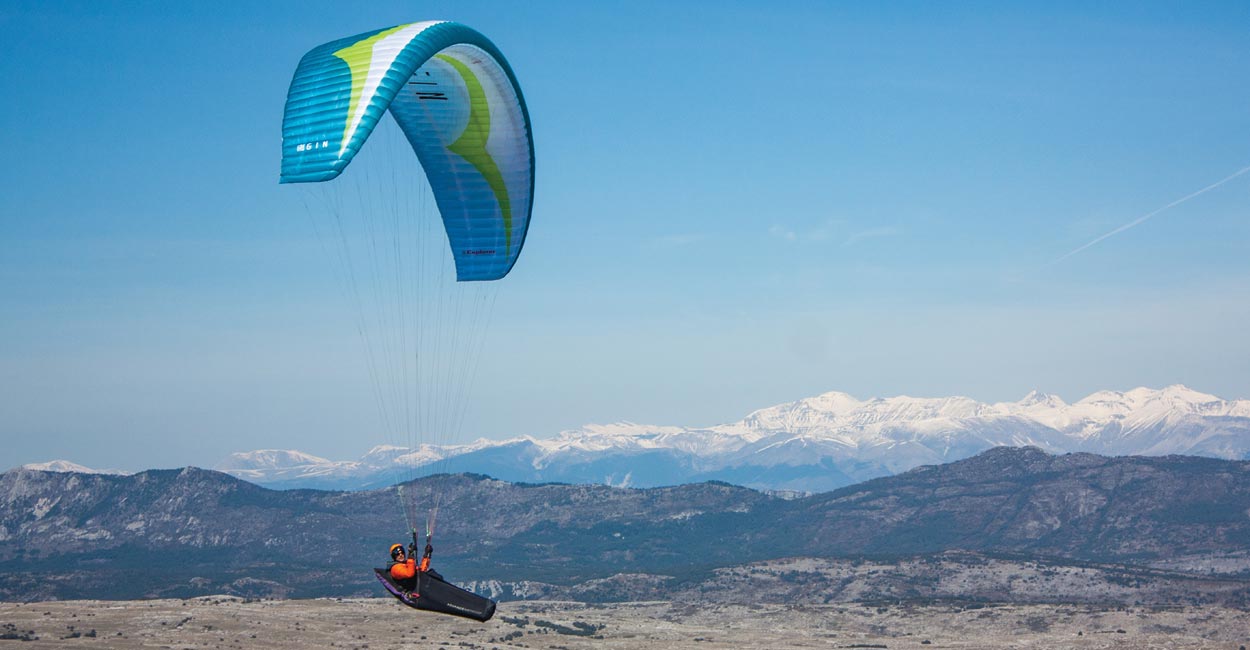
FROM THE MOMENT YOU UNROLL this wing you feel like you have a racy machine on your hands. With an aspect ratio that is above the magic figure of six it looks like it is meant to glide to the horizon. The big ‘Fly GIN’ logo on my demo wing only enhanced the racy impression.
But looks aren’t everything: just take a look at the Nova wings with their low-aspect designs. A friend said, “They don’t look like they should go well but they most definitely do!”
So does the Explorer with its sleek racy lines deliver the performance it promises – and does that come at the cost of comfort or handling?
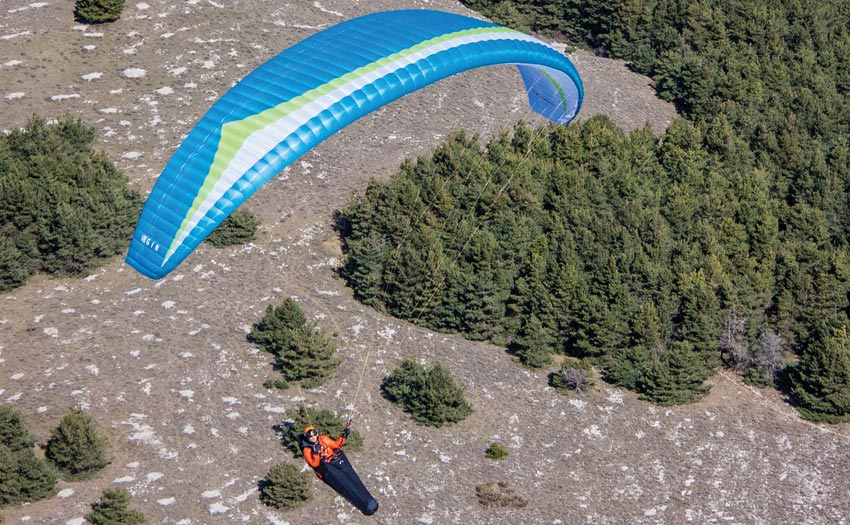
Launching
I came to the Explorer from a much heavier wing. As a result my first take-off was far from graceful. The wind was pretty strong and gusty and I pulled unnecessarily hard on the As. Of course the wing raced overhead and I instinctively hit the brakes to stop it surging overhead. All the energy was converted into lift, plucking me off my feet then unceremoniously dumping me in the middle of launch.
I was lying on my back in the gravel but despite my flailing the wing had managed to settle overhead. With a few dabs of the brakes I was able to regain my feet, let the wing fly and we took off into the sky as if nothing had happened. Lesson learned: only a light touch is needed on the ground.
After that initial heavy-handed launch all the launches were perfect, even when others were having trouble in crosswind. With a lighter touch the wing comes up smoothly overhead. It takes the smallest of dabs on the brakes to stop it moving forward, showing good pitch stability. For sure its relatively high aspect ratio compared with many other Bs means it can yaw a bit, but the brakes allow you to control this easily.

Construction
This is GINs lightweight vol-biv machine. Many will automatically think it is a lightweight version of the Carrera, but it is in fact a newly designed wing. Aspect ratio has been slightly reduced for a start from 6.2 to 6.1. Upfront there is a well defined sharknose, shaped using twin plastic rods. There are also additional plastic rods around the C tabs to spread the load in this area. At the back you will of course find miniribs to keep the shaping in this vital part of the aerofoil clean.
The sail is made from Porcher Skytex 32 and 27: a good compromise between durability and weight. Unusually the wing is available in only two standard colours. The lines are unsheathed and uncoloured with the upper lines being particularly thin. Launching, I managed to catch an outer upper C and it broke easily, so a little care has to be taken when laying out the wing on less than perfect launches. Where the main lines attach to the maillons there is a section of colour-coded sheathing which helps you differentiate the lines and reduces wear.
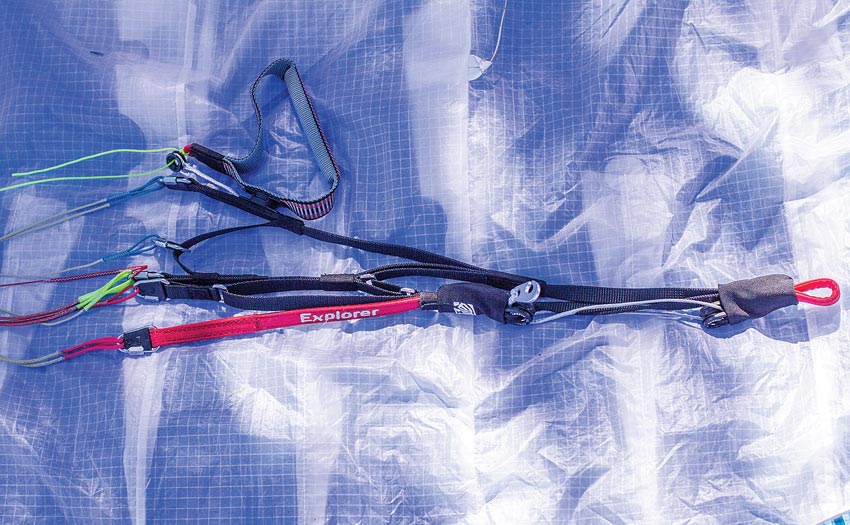
The risers are very distinctive and made from slim webbing; the A-risers are predominantly red in colour with the Explorer logo embroidered on them making them very easy to distinguish on the ground. The brakes are held in place with magnets with shaped plastic housings, which GIN have been using for a while. The brake line, which is thinner than on many wings, runs through a ceramic ring rather than traditional pulleys. As you would expect from such a major brand everything is very well finished and uses quality parts.

In the air
Instantly noticeable as I carved into the first bit of lift was the precise nature of the handling. The brakes have an immediate effect with very little travel needed to move the wing. Adding a dose of weightshift helps it get up on a wingtip for tight cores. The brakes are of medium weight, and ramp up if you pull hard – you get a good feel for what the wing is doing through the brakes.
Talking about feedback, the wing is pretty talkative itself, passing lots of information about what the air is doing through both the brakes and harness. You should be able to make the most of the lift. I love the level of info it gives, but I guess some less experienced pilots may find it a bit too much. However, the wing doesn’t move about too much: it is well damped, especially in pitch, and despite its lightness there is no constant pitching. GIN has achieved a remarkably comfortable ride for this class of wing.
During my time with the Explorer I was also able to fly a Nova Mentor 4 Light, another wing aimed at vol-biv adventure pilots. In the same air I found that both wings have a pretty similar level of comfort, with the Explorer having just a little more damping in pitch. I found it easier to bank the Explorer over in tight thermals, with the brakes being that bit more reactive in the first part of the travel. Looking at the specs this is somewhat explained by the smaller area of the Explorer – it has a flat area of 25.5m2 as opposed to 28.39 m2 for the Mentor. Both wings are certified to be flown to 110kg, but flying at just over 100 I felt I had more authority on the Explorer.
Thermalling
That pitch stability is particularly noticeable when thermalling. As I climbed out of a windy Gourdon on my first flight I found the wing needed little controlling. There was very little pitching entering thermals, it just gets sucked in and up. Dial in the appropriate bank angle with inner brake and weightshift then control the wing with small movements of the outer brake.
Like most modern wings it felt like it likes to fly fast in thermals. Too much brake and it feels like you are choking it; let it off the leash and it’s full of energy you can make use of to cut into the better parts of the lift. Modern wings have polar curves that see the minimum sink at, or very close to, trim speed, so you gain nothing by slowing the wing down. In fact you can make the sink rate worse as you slip down the side of the graph.
Even in the windblown thermals I didn’t find I had to make any frantic arm movements to keep the wing in check. We just went round and round together climbing. Despite the aspect ratio it works well as a single wing, with very little bending in the middle.
By the end of my time with the wing I was happily thermalling one-handed, taking pictures with the other, on a strong day with powerful thermals.
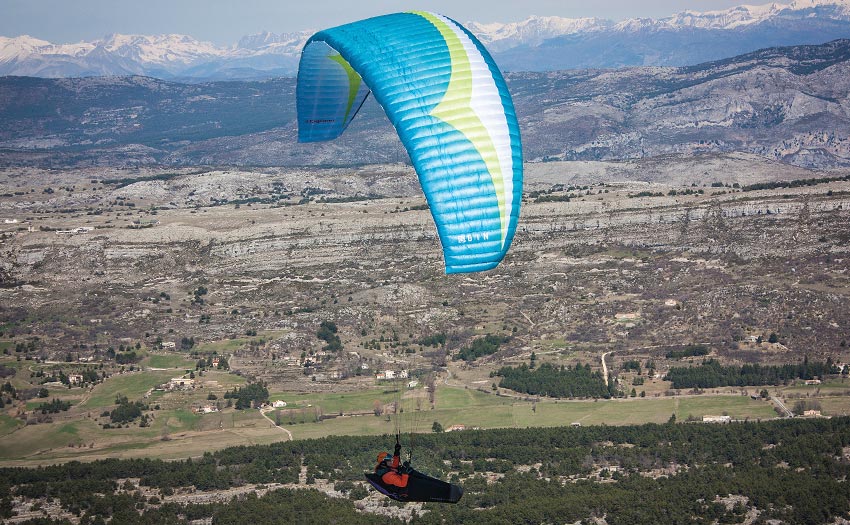
Cross-country flying
I managed to get out on a couple of good XC days in the south of France. On both occasions I found myself in the company of Enzo 2s and Zenos. Climbing out of Col de Bleine on my first XC on the wing I had one of those whoop-whoop moments in a strong thermal wingtip-to-wingtip with a Zeno. I felt there was very little between us in the strong climb even as we moved through the more broken parts pushing in and out of bits of lift. This is not overly surprising though, as when the air is moving up that fast you won’t see too much difference in performance if both wings have handling that enables you to make the most of it.
What was more unexpected was on the first glide with an Enzo 2 I found myself in close company with him for the next 15km. With reasonably windy conditions, especially low, we were making the best use of the broken convergence we found so he wasn’t hooning off on full-bar. But at a mix of trim and half-bar we weren’t so different from each other. It shows how far modern top-end EN Bs and Cs have come with their ability to cut through the air and float up through broken lift. I am not saying the Explorer is a Zeno beater, just that with the latest generation of sports wings the gap has been closed at lower speeds.
A few transitions later I got to see how the wing performed alongside sports class wings as I headed on glide for a few kilometres in the company of an Ozone Alpina 2 and a Skywalk Spice; both lightweight EN-C wings. There was no real difference between the three. I felt the Alpina and the Explorer had the edge in terms of speed, but it is hard to know how much bar everyone was using. It’s all very unscientific, but the main thing is we all arrived at the next hill at very similar heights, so there was no practical difference in performance, a feeling I kept while gliding with sports class wings for the rest of my time with the glider.
On bar the wing feels safe and secure, with very little pitching or movement, and it feels even more taut than at trim speed. The bar pressure is reasonably light so you can control it well with your feet. There are no rear-riser handles or loops, but I found I could get a good feel for the wing just holding the rear-risers – pulling back and down gave finer control than my legs.

Security
During my time with the wing, more than 15 hours, I only had one largish asymmetric collapse, but that was no more than 40%. That was despite some rather punchy, and at times windy, spring conditions down in the south of France with 6m/s climbs. The passive safety seems good with the wing well pressurised. Occasionally a wingtip would come in if you found the edge of a thermal or in turbulence, but I would much rather this than the wing suddenly snapping into a big collapse.
On my second XC I flew a 60km circuit around the local area. At one point I had to push forward into a valley with sea air blowing quite strongly up it. I was low as I pushed forward over the cliffs on the side of the valley. It’s an area known for its turbulent air but I felt confident in the wing pushing into the wind. Thanks to the precise handling I was able to control the wing as I pushed crosswind along the cliffs, working small but strong bullets of lift.
I found that both induced and real collapses are non-events. It was straightforward to maintain direction and the wing recovers spontaneously, with a pump just speeding things up a little. Big ears are easy to pull and hold; adding a bit of bar makes them effective for descending and getting away from the source of lift.
Conclusion
The Explorer is a wing that left me with a grin on my face. It has performance that puts it on a par with other wings at the top of the B-class and has sharp and direct handling for a racy feel. It’s not a first EN-B wing, but is ideal for pilots that want a step up in performance and feel without losing out on passive security. I can see it also appealing to more experienced pilots who still want dynamic sharp handling in a safer wing.
Being lightweight opens up new possibilities too: paired with a lightweight pod it’s a great adventure/travel wing that won’t be lacking in performance. It allowed me to walk up to higher launches that work earlier to maximise the day. Less weight on our backs can only be a good thing, and wings like the Explorer allow for sub-10kg packs that still offer full-weight XC performance.
****
Q&A: MICHAEL SIGEL
What were your goals when you set about designing the Explorer?
We could see the Carrera had the potential to be a legendary wing, so we wanted to improve the concept by keeping the high performance while at the same time increasing pilot comfort and usability. We wanted the Explorer to appeal to a wide range of pilots. The current trend is to make the wings lighter, so from the beginning we wanted the Explorer to be lightweight. The idea was to make a wing that is easy to fly and easy to use. As the wing is lightweight this automatically helps make the handling easy: packing is easy; travelling is easy.
People are calling it a ‘Carrera-light’ but how different is this wing design?
The Explorer has a redesigned profile, changed sail tensioning, line materials and uses different line calculations. Of course, the gliders come from the same family, but it’s a totally new glider.
There are no rear-riser loops or handles, does this mean you don’t recommend rear-riser control when on speedbar?
One reason for this is that we wanted to make the risers simple and light. Also, it’s possible to grab the C-riser on the connection to the C3 riser and this works quite well. But we recommend our pilots use C-riser control only moderately and only try to correct small pitching with the risers. Bigger surges should be controlled with the speedbar. The glide will appreciate that.
What is your target market for the wing?
The better question is which market is the glider not made for? And the answer is: dune-soaring, competition and acro. Apart from those the Explorer can be used for just about anything. It is light, so you can take it for hike-and-fly, or travelling, with a pack weighing as little as 7-8kg. I’ve also used the glider for fly-and-ski. Antoine Girard is currently in Pakistan with the Explorer for another big adventure.
You have certified the wing with an extended weight range, why?
During the certification flights of the S, we discovered that the test pilot was flying too heavy. However, the manoeuvres were still good and were not very different to those done flying at 95kg. With the extended weight range we can help pilots who would be between two sizes, or those who like to have a more dynamic glider but still want to stay within a certificated weight range.
You are one of the few companies that certify your wings with a pod harness. What differences do you find when doing the certification flights with a pod?
We just tried it out of curiosity, because we wanted to know the differences between flying with a pod and a normal harness. During certification of the Atlas and now Explorer we did not find a big difference. That’s good – if the reaction was bad how could we have launched a glider we knew would behave differently under real conditions than when it was certified? We assume 70-80% of pilots will fly the Explorer with a pod harness.
What’s coming next?
We just certified all sizes of the Boomerang 11 and are excited to race with the Enzo 3. Then we will launch the Osprey, a 34m2 tandem glider for regions with a lot of wind. The Vantage 2 will come out this spring – an intermediate PPG that can be used for free flying too. Also we are working on a new C glider, and of course we are trying to make a new glider for our X-Alps athletes!
MANUFACTURER’S SPECIFICATIONS
What GIN say: “A lightweight sports performance wing aimed at seasoned XC pilots who want to fly a wing that’s comfortable, responsive and performant”
Use: XC, vol-biv and travelling
Pilot level: Intermediate XC pilots +
Sizes: XXS, XS, S, M, L
Flat area (m²): 20.1, 21.6, 23.6, 25.5, 27.6
Recommended take-off weight (kg): 55-75, 65-85, 75-95, 85-105, 95-115
Extended take-off weight (kg): N/A, N/A, 75-100, 85-110, 95-120
Glider weight (kg): 3.2, 3.4, 3.7, 3.9, 4.1
Cells: 59
Flat aspect ratio: 6.1
Certification: EN/LTF B
Marcus King flew the size M over 15 hours flying at 100-104kg using an Advance Impress 3 harness
To stay up to date and read our reviews first, subscribe to Cross Country



